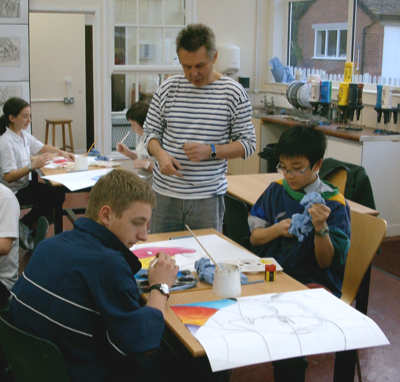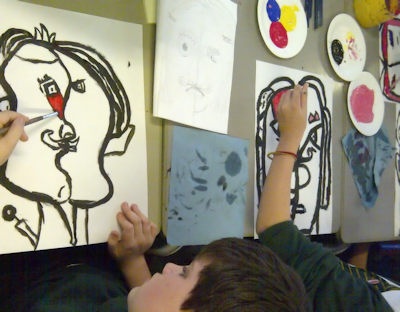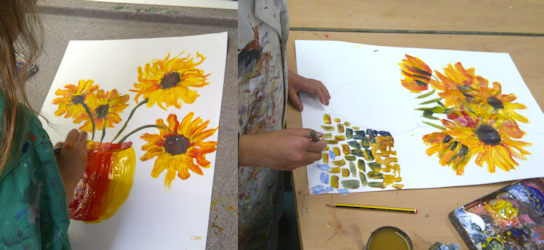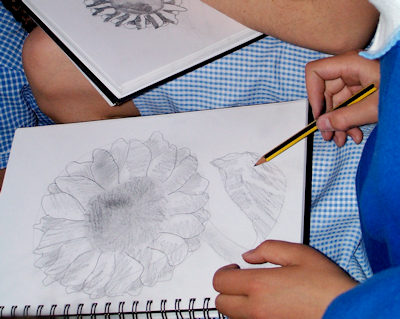The Importance of Art Education
Art Education’s Battle to stay Relevant
I have been involved in art education in schools for years before leaving and setting up my own art business. Initially, I provided schools with art workshops, but I now concentrate of producing Art History and Drawing Tutorials on YouTube. A few years ago I was in a secondary school in Reading, UK – lovely school – running a GCSE Inspiration workshop with around 60 15/16 year olds. I had a wonderful day and was well supported by the Art Staff.
At lunchtime I sat down with the whole art department and they told about the issues they faced. They spoke of falling numbers in art, the hostility of some academic staff to the subject and children commenting there is no future or jobs in art. It reminded me of what I see as one of the fundamental problems with education in secondary school in this country (UK) and probably many others around the world. Namely, the down grading of the arts in pursuit of academia.
Of course, academic subjects are vitally important for children’s and the country’s future, but so is art education. Some (not all) academic staff in that school (and I have experienced the same myself), referred to art lessons as ‘playtime’, or the ‘dumping ground for the less able’. Those attitude are demeaning to art teachers and art teaching. They are also detrimental to the impartial advice, that should be given to teenagers when opting for GCSE subjects. How do art teachers respond to such attitudes from colleagues? I remember the response of an art colleague of mine to similar attitudes from an history teacher. His reply was simply, ‘Historians are merely prophets of the past, artists and designers create the future.’
The Justification for Art Education
Whilst petty-minded attitudes of some academic staff to art education is simply that – petty. It shouldn’t be allowed to influence the attitudes of children. This is where art teachers have a roll to play. Art Teachers need to promote their subject to the school. Not merely by mounting wonderful art displays and their teaching, but educating the school community to the contribution art makes to our society. Children and staff should be aware that virtually everything human beings produce or sell has an artist or designer involved who has had an art education. It doesn’t matter whether it is the creation of the idea, the design of the product or its marketing artists and designers are vital.
Examples of the profound effect artists/designers have on the production of wealth and jobs in society should be appearing in art rooms and display boards in school corridors for all to see. Perhaps the best example is Jonathan Ive. He studied art and design at Newcastle Polytechnic before becoming chief designer for Apple. He, and his team, were responsible for redesigning the Apple Mac into the iMac, and the design for the iPod, iPad and crucially the iPhone. Before the redesign of the iMac, Apple were a niche computer company run by the technical guru and perfectionist Steve Jobs. Apple then had around 5% of the computer market at the time. It could be argued that it was Jonathan Ive’s designs that transformed Apple into one of the world’s largest companies, that it is to day.
It is also interesting to note that virtually all major London City banks and multi-national corporations, major manufacturers and blue chip companies invest heavily in Innovation Departments. They are crammed full of creative individuals and artists, because you need creative ideas to compete in the modern world.
Art Education’s Role in Child Development
Whilst extolling the virtues of art education’s contribution to society is important. Perhaps art education’s role in the curriculum up to the end of GCSE (16 year olds) is the issue that is important for academic staff to understand. Let’s face it, a lot of academic teaching, up age of 16, involves feeding children with a stream of facts, processes, techniques and formulas that have to be learnt. Only to be regurgitated, in a different form later in examinations. Along the way children are trained how to pass the examination and as a result targets for GCSE passes are met. This system requires little independent thinking on the part of the child, and virtually no conceptual thinking. This perhaps explains why so many students find the leap from GCSE to the more conceptual thinking behind A Level (17-18 year olds) so difficult.
Conceptual Thinking
Conceptual thinking is the basis of art education and its development a key part of art teaching. The ability to think conceptually is important and probably explains why many students find Art a difficult subject in which to achieve success. Students are so spoon fed in many parts of the curriculum that when asked to think for themselves, develop an idea or a strategy to achieve an end, they struggle. The development of conceptual thinking is vital to the student mind. It enhances a student’s creativity, their problem solving skills and would, in my opinion, be an absolute boon to academic subjects such as Mathematics and Science.
Great Art lessons provide children/ students with the opportunity to develop their conceptual skills. With these skills they are able create, problem solve and think independently. Recently, I looked at a GCSE Art Examination paper and realised just how challenging it was. Questions consisted of just a single word, for example, ‘Openings’ or ‘Atmospheres’ with a list of artists names attached. From this starting point a student is expected to spend weeks developing an idea. They have to research the cultural and artistic links, prepare and refine their ideas. and learn new skills in preparation for their 10 hour examination, when the final art work is produced. The self motivation and conceptual thinking required to achieve the top grades is enormous. Because, we know as art teachers, it is not just a talent for the techniques that will get a student through.
So I would like to say to all art teachers keep up the good work. Be proud of your subject, your teaching, extol its virtues to the less receptive in your school and keep battling to develop your student’s creativity, because this country future depends on their ideas and creativity. Rant over!
In Summary
I haven’t mentioned the importance of being an artist, about how art reflects society, the beauty of art and also it’s political dimension. That is for another day. Finally, I have met a lot of brilliant academic teachers over the years that do value the role of art. One in particular I’m indebted to, Dave Walsh, who got my arts based son, through A Level Maths (Grade A)











Comments
No comment yet.